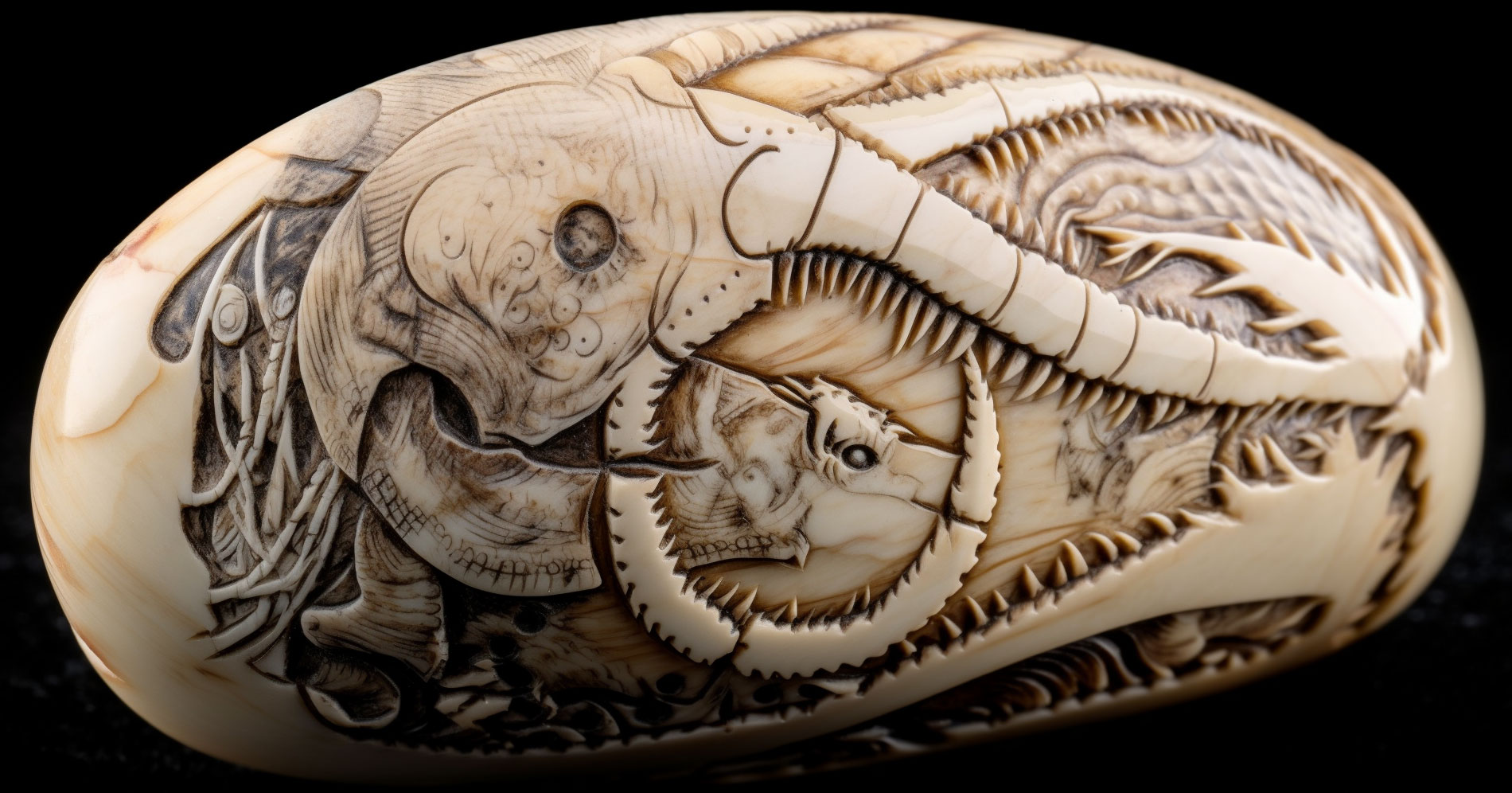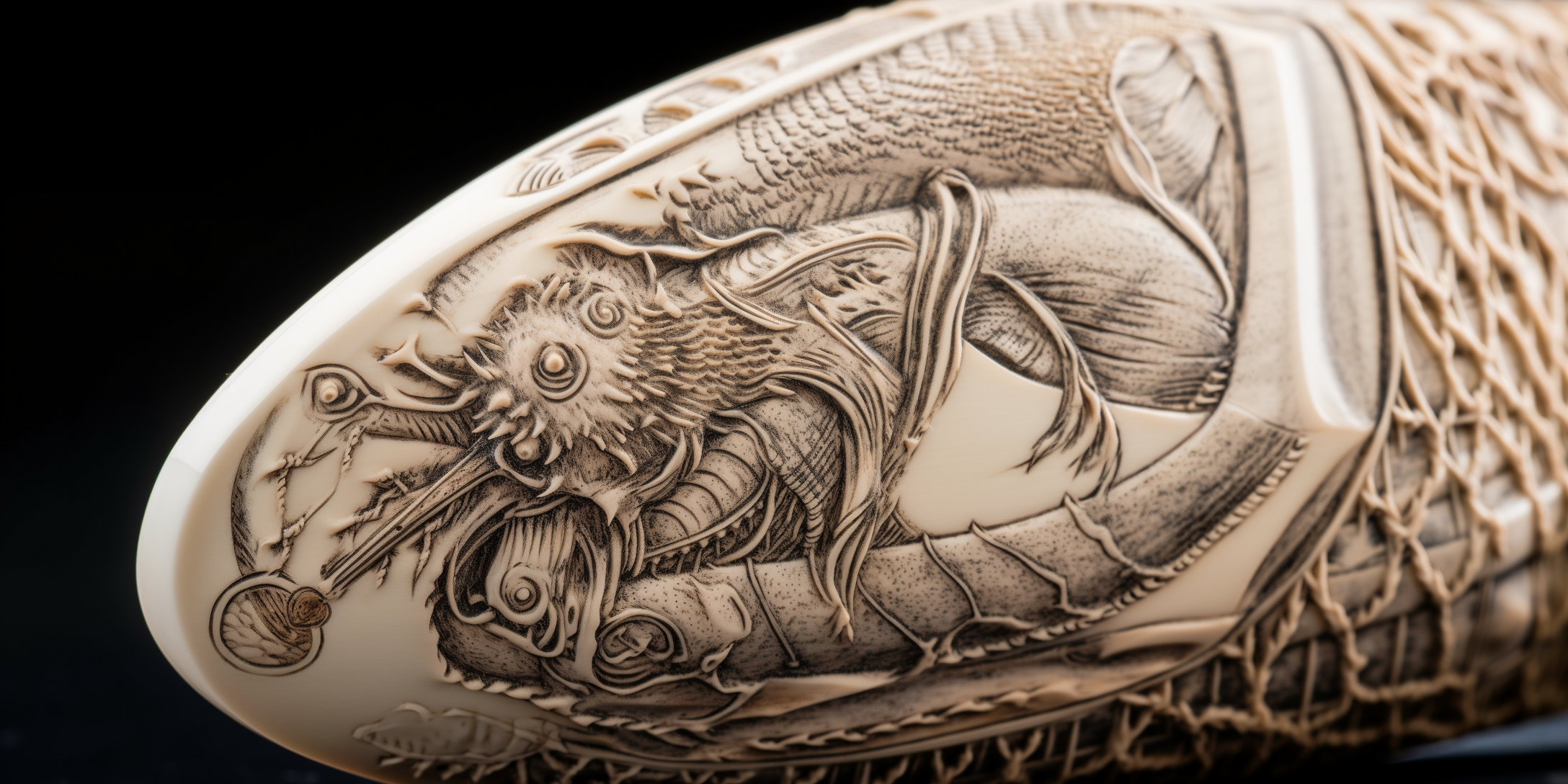Summer Scrimshaw Festival
Adolescent Molts
Threshers frequently molt as they grow from prepubescence (when their chitin is soft and flexible) to their adult size; some of the plates of carapace that they molt are often repurposed into tools, small finishing pieces for furniture, and--most commonly--artwork. Most molted chitin of reasonable thickness is as sturdy and enduring as seashells, so keepsakes made from it can be passed down many generations without wear. Many families enjoy assembling the smoothest and sturdiest pieces of their children's molts into a patchwork timeline, often painted, inked, or engraved by the parents or older siblings with representations of the child's favorite things during that age. Particularly artistic adolescents may decorate the molts themselves, usually showcasing their evolving styles and command of the tools they choose to use. Because molts are so plentiful, even less sentimental families find pragmatic uses for them. Depending on the family's industry, the adolescent will often receive their first tools (small pocket knife, knitting needle, trowel, screwdriver, etc) made from or decorated by their own molts. Their training tools are quickly expended through heavy use but are just as easily replaced by tools made from the next molt.Unrestrained Summer Fun
Most thresher youths molt during the summer, as the process expedited by vigorous physical activity, long soaks and swims in temperate water, and sweat from their still-human skin. It only takes a few weeks for a piece of shed chitin to dry and harden to a point where it can be carved or painted, so the White Cities host a number of local art festivals dedicated to new works of art from fresh molts. There are usually three categories - ink, paint, and scrimshaw - that take place at different times of the year. Inkwork is celebrated during the autumn harvest, and painting during the winter. The summer festival is for scrimshaw, as carving the pale chitin is considered a time-consuming and intricately-detailed task, usually reserved for adult siblings or parents of children who've molted. The scrimshaw festival features the artwork resulting from the prior summer's molts, and some pieces are traded or offered for sale by those who do not wish or need to keep them for family sentiments. (Many professional artists pay unrelated youths for spare molts so they can participate in these festivals even without children of their own.) The festival always includes hands-on opportunities for children and adolescents to try engraving castoff sections of older molts; elegant scrimshaw may be considered an adult form of artwork, but no one is barred from experiencing it. Some few youths may take a shine to the process and decide to try engraving their own molts throughout the coming seasons, and many more experienced adults encourage these novice efforts. Scrimshaw as a hobby, or rarely as a trade, is valued as an activity that teaches patience, carefulness, dedication, steadiness, and keen observation to participants of any age and skill level.Artistic Themes
Threshers are particularly given to making abstract patterns with their scrimshaw, especially for those new to the craft; more skilled artisans enjoy challenging themselves with half-abstract themes for each piece. Some festivals may categorize these two things separately for purposes of awarding prizes or recognition to particularly noteworthy pieces; competition is not very common in the art venue among threshers, but it's not nonexistent either. Much like poetry and song can viewed as deeply subjective, emotional types of art, thematic scrimshaw pieces possess the same air of enigmatic meaning that lies below its visible surface. Threshers are not given to spiels of philosophy, but scrimshaw allows them to imbue personal experience and cultural symbolism in layers of subtlety and texture on each piece. It is not uncommon for threshers to catch a faint hint of emotional depth through their mental connection to other threshers when viewing a masterwork when the artist is nearby. As with any kind of art, however, thematic scrimshaw can also be used for satire, caricatures, and one-dimensional jokes. The amount of time it takes to do a single piece makes it less prime for quick commentaries on current events, but that doesn't stop every artist from using it to make a physically-enduring statement.From the Outside
Many thresher festivals or community events are open to their non-thresher neighbors, but scrimshaw is not. Other people have wildly differing views on it, from a respect to the craft to an appreciation of the family-building history to an unspoken horror at making art out of children's discarded body parts. (Needless to say, molting is an entirely natural process and reusing molts is practical, not macabre as some non-threshers seem to think.) A few non-threshers do scrimshaw out of elephant ivory, whale bone, or dragon teeth. These are considered rare and valuable treasures worthy of a noble's showroom or a merchant's most prized offerings, but threshers and non-threshers alike do not consider these in the same vein as molt artwork. It is likely that one or two pieces of molt scrimshaw have made their way out of the White Cities and have been mistaken for more traditional scrimshaw, but threshers make a point to never import non-molt scrimshaw, not even to resell to non-threshers. Ultimately, scrimshaw is a deeply cultural and communal part of thresher families, and it is belabored and beloved like few other things in the Godhurst Colonies.Remove these ads. Join the Worldbuilders Guild











Comments